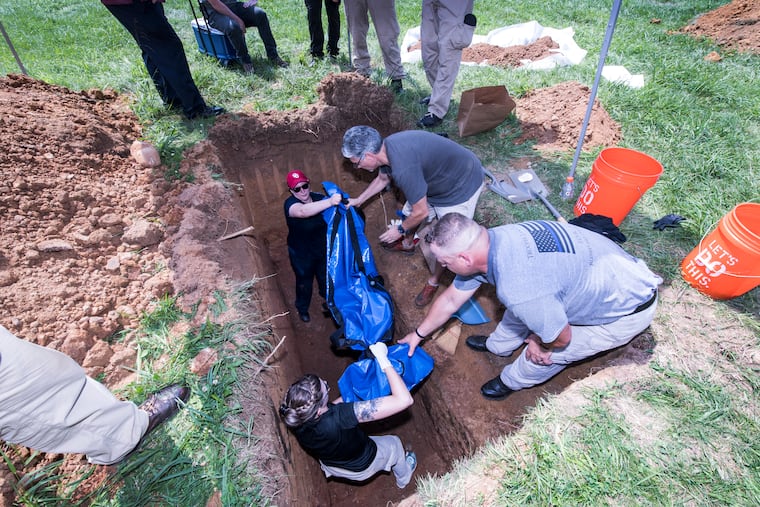New mysteries unearthed at Philly’s last potter’s field, where the Boy in the Box once rested | Mike Newall
The dig for the Girl in the Box, a long forgotten child found floating in the the Schuylkill in 1962, is part of an effort by state and local police — and national experts — to identify some of nearly 300 nameless dead still on city scrolls

We stood in the middle of the lonely patch of grass in Northeast Philadelphia, in a grove surrounded by tall oaks, where faint depressions in the grass were the only indications that bodies are buried there.
In this, the city's last potter's field, a cluster of state police, forensic anthropologists, and homicide detectives probed the soil Tuesday, searching for the remains of a little girl found in a box in the Schuylkill in 1962.
A little girl mostly erased from the city's memory.
Her obscurity becomes an even greater indignity when you consider that the unidentified child for so long shared this stretch of earth, near Byberry Road, with another Philadelphia mystery: the Boy in the Box, the toddler found in a cardboard box in some roadside woods in Fox Chase in 1957, perhaps the city's most studied unsolved crime.
Unidentified himself, the boy has captured the attention of a city for more than a half a century.
The Girl in the Box has never been afforded that kind of scrutiny.
"Just like Boy in the Box of the 1950s, this was the Girl in the Box of the 1960s," said Lehigh County Homicide Detective Thomas McAndrew, formerly of the state police and now president of the Pennsylvania Homicide Investigators Association. "But no one knew about her — a little black girl largely forgotten."
Not by everybody, he quickly added. Not anymore, at least.
The child was believed to have been between 4 and 6 years old when her headless corpse was found in a wooden milk box floating in the river near Passyunk Avenue. She had been decapitated and burned, one of her fingers amputated and bandaged. Her remains had been wrapped in an apron and a copy of the Sunday Bulletin dated March 11, 1962.
The dig for her remains is part of an effort by state and local police — and national experts — to identify some of nearly 300 nameless dead still on city scrolls, dating back to the 1950s. And to solve the riddle of some of their deaths.
It's a charge led by McAndrew, who has worked murders for 20 years, and Erin Kimmerle, a renowned forensic anthropologist from the University of South Florida. She has dug in overseas war zones to identify the victims of atrocities. And she's dug to identify the victims of American atrocities, too — like those who suffered horrific abuse at a boy's school in Florida, buried in unmarked graves in a makeshift cemetery. The body of one boy, Thomas Curry, a runaway from the school who died from a crushed skull, was sent home to Philadelphia in 1925.
When Kimmerle cracked the lid of his coffin in Old Cathedral Cemetery in West Philadelphia in 2014, the mystery only deepened. The coffin was empty.
That's the sad reality of their work. Even with all the new technology and dedication, when you're probing the dirt for answers in decades-old crimes, sometimes there's only so much you can find.
For his part, McAndrew has become a vocal advocate for reforms that would help police better take advantage of the dizzying array of identification technology now in their grasp. He's long called for stricter mandated national and state databases that help police link the missing with the unidentified dead.
He hopes the attention could cause families who may have given up hope to step forward.
A federal grant dedicated to unsolved homicides led Kimmerle and McAndrew to the file of the Girl in the Box, gathering dust in the city archives, and this old potter's field. (The grant expires later this month — they sneaked the Philly dig under the wire.)
The field was decommissioned in 1987 — no more room, officials said at the time — and now the anonymous dead are stored in cold cabinets at the morgue. The Boy in the Box was reburied at Ivy Hill Cemetery in 1998.
The Girl in the Box and the remains of six other young people that Kimmerle and McAndrew hoped to find were left there, languishing in unmarked graves.
There are no societies dedicated to solving these cases. No Wikipedia pages, no internet sleuths searching for their names. Just 6-by-3-foot graves, cheap particleboard coffins — a pine box even too pricey a luxury, apparently — and a cheat sheet that McAndrew hands out with the stark, sparse details of their deaths.
Grave 522: a teenage boy found shot to death in 1977 near some railroad tracks along Delaware Avenue.
Grave 530: a teenage boy stabbed to death and found floating with weights in a Port Richmond creek.
Grave 550: the partial remains of a young woman found also in 1979 in a sewer system in a Tioga sewer.
Their remains were all recovered, with three more graves set to be opened Wednesday and Thursday.
They had opened the Girl in the Box's grave first, and dug down to where they thought she rests, but had not found her. By day's end, they narrowed their search to a few yards of earth nearby. Come morning, they planned to search anew, determined to find a little girl, no longer forgotten.